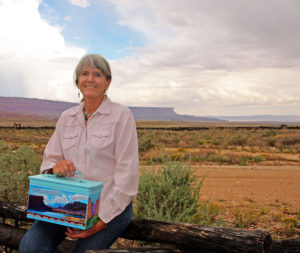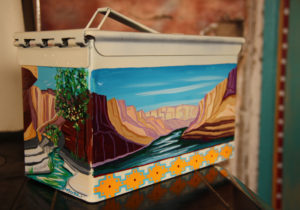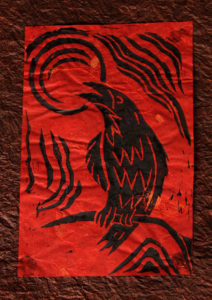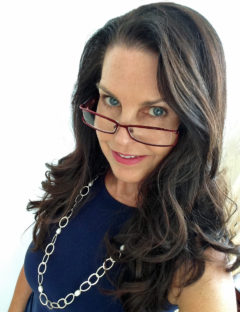![]() November 2011
November 2011
Story & Photography by Gail G. Collins
 Twenty-two years ago, Simone Stephenson didn’t expect to move to a remote parcel of land at the bottom of the Kaibab Plateau. After she did, the painter planned to practice her art during the off season from river work. So recently, when Stephenson’s husband, Tim, went to the Post Office, perhaps he should’ve expected to come home to a vivid, tri-colored door.
Twenty-two years ago, Simone Stephenson didn’t expect to move to a remote parcel of land at the bottom of the Kaibab Plateau. After she did, the painter planned to practice her art during the off season from river work. So recently, when Stephenson’s husband, Tim, went to the Post Office, perhaps he should’ve expected to come home to a vivid, tri-colored door.
Shocked by the red, teal and gold panels, Tim said, “Do you think just because you’re an artist, you can paint anything you want?” Equally shocked by the question, Stephenson said, “Yes! Don’t you like it?” He did. Stephenson chuckled, retelling the anecdote and wondered aloud, “So, what’s the problem?”
The amiable artist stumbled into the remote existence near the Kaibab Plateau and Vermillion Cliffs by chance. A friend hosting school children on a river trip needed another chaperone, so Stephenson hitched along. She fell for the dramatic beauty of the place and soon bought a 134-year old home there, which was then in ruins. “I always wanted an outdoor job in a beautiful place,” the Alaska native said, pointing through the window at the cliffs. “Here, I’d have time in the winter to practice my art.”
Always an artist, Stephenson took classes in high school and received an art degree from Humbodlt State University. The northernmost California climate mirrors her present location.
Still, gravitating back to painting waited until Stephenson had raised two daughters and visited a long list of travel destinations. Those stops included Polynesia and Australia, Europe and Mexico. The influence is obvious. Wood trim in the house and several forms of self-expression on the wall—ranging from water colors to punched tin to block prints—boast bright hues reminiscent of the islands and South America.
 “I enjoy art for art’s sake,” Stephenson said, “but it’s nicer to have art you can use—like in Mexico where they paint their trucks. They’re wonderful.” In a similar concept of functional art, Stephenson started painting ammunition boxes at a suggestion from a friend. The sturdy, metal boxes are known to used regularly on Grand Canyon river trips, and in the canyon to protect food from scavenging animals.
“I enjoy art for art’s sake,” Stephenson said, “but it’s nicer to have art you can use—like in Mexico where they paint their trucks. They’re wonderful.” In a similar concept of functional art, Stephenson started painting ammunition boxes at a suggestion from a friend. The sturdy, metal boxes are known to used regularly on Grand Canyon river trips, and in the canyon to protect food from scavenging animals.
Brushwork landscapes on the ammo boxes are replicas of scenes where Stephenson regularly finds herself. “Working in the Grand Canyon is an amazing experience—the river, the side canyons, small oases, birds, animals—everything is around me.”
Ravens seem to be a favorite subject for Stephenson. “They’re amazing  birds—so smart—they can live for 50 years and even mate for life. Ravens are important to many cultures, including Native Americans, and are a constant inspiration.”
birds—so smart—they can live for 50 years and even mate for life. Ravens are important to many cultures, including Native Americans, and are a constant inspiration.”
Though a couple of Flagstaff shops offer Stephenson’s painted ammo boxes for sale, river trippers make up the bulk of her customers. “People love to buy them as mementoes of their time on the river.” She is sure they take them home and fill them with jewelry or other such collectibles, but Stephenson straps her boxes on the boat, too.
Stephenson is a renaissance woman, teaching herself new art forms as she encounters them. This led to punched tin. Her husband bought the necessary supplies to get started, and Stephenson began making plaques or frames to coordinate with her block prints. Some of her original prints are backed with handmade papers for one-of-kind appeal and are signed like her notecards.
Other than art, Stephenson has done a host of outdoor jobs. She has worked river trips, cooked for the Parks Service on a variety of outings before swamping on river expeditions, and lately, cooks for crowds of 350 during the spring guides training seminars. And in the winter, she practices her art, as she planned.
Stephenson’s artwork shouts from the neutral backdrop of her home’s stone and wood. A sun rises over the entryway, bison graze on kitchen cupboards—a scene from a Wyoming trip—and worn oars bare patterns. “I think sometimes, I should get rid of things, but what would that be? I’m just never going to have a grown-up house,” she said.
Being off the beaten path, unless one is beating it to Grand Canyon’s North Rim, could be a solitary existence. So sometimes, a cadre of artist friends kidnap Stephenson, and they paint at the canyon rim for an afternoon. “It’s important to go to galleries and art shows to see other people’s work and learn new techniques from one another. “ Still, she insisted, “I like my peace and quiet.” NAMLM
